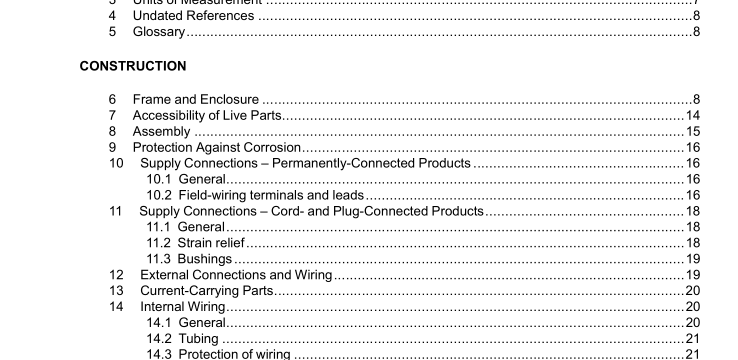UL 1564-2020 pdf download.Industrial Battery Chargers.
4 Undated References 4.1 Any undated reference to a code or standard appearing in the requirements of this standard shall be interpreted as referring to the latest edition of that code or standard. 5 Glossary 5.1 In the following text, the term “product” is used to mean an industrial battery charger. 5.2 For the purpose of this standard, the following definitions apply. 5.3 CLASS 2 TRANSFORMER – A step-down transformer complying with the applicable requirements in the Standard for Low Voltage Transformers – Part 1: General Requirements, UL 5085-1 and the Standard for Low Voltage Transformers – Part 3: Class 2 and Class 3 Transformers, UL 5085-3, or the Standard for Class 2 Power Units, UL 1310. 5.4 INDUSTRIAL BATTERY – A battery that is intended for cycling service and is rated in number of cells and in ampere-hours delivered at the 6-hour discharge rate. 5.5 LIMITED-ENERGY CIRCUIT – An ac or dc circuit having a voltage not exceeding 1000 volts and the energy limited to 100 volt-amperes by either a secondary winding of a transformer, one or more resistors complying with 24.4.10 and 24.4.11, or a regulating network complying with 24.4.1. 5.6 LOW-VOLTAGE, LIMITED-ENERGY (LVLE) CIRCUIT – A circuit involving an alternating current voltage of not more than 30 volts, rms (42.4 volts peak), or a direct current voltage of not more than 60 volts and supplied by either of the following: a) An inherently limited Class 2 transformer or power unit or a not inherently limited Class 2 transformer or power unit and an overcurrent protective device that is: 1) Not of the automatic reclosing type; 2) Trip-free from the reclosing mechanism; and 3) Either not readily interchangeable with a device of a different rating or a marking in accordance with 48.5 is provided. b) A combination of an isolated transformer secondary winding and one or more resistors or a regulating network complying with 24.4.10 that complies with all the performance requirements for an inherently limited Class 2 transformer or power source.
6.7 The diameter of the wires of a screen shall not be less than 0.0598 inch (1.519 mm) if the screen openings are 1/2 square inch (3.2 cm 2 ) or less in area and shall not be less than 0.100 inch (2.54 mm) for larger screen openings. 6.8 Perforated sheet steel and sheet steel used for expanded metal mesh shall not be less than 0.042 inch (1.07 mm) thick, 0.058 inch (1.47 mm) thick if nonferrous, if the mesh openings or perforations are 1/2 square inch (3.2 cm 2 ) or less in area, and shall not be less than 0.080 inch (2.03 mm) thick, 0.112 inch (284 mm) thick if non-ferrous, for larger openings. Exception: In a small charger where the indentation ofa guard or enclosure does not affect the clearance between uninsulated, movable, current-carrying parts and grounded metal, 0.020 inch (0.51 mm) steel or 0.029 inch (0.74 mm) nonferrous expanded metal mesh maybe employed, provided that: a) The exposed mesh on any one side orsurface ofthe battery chargerthat is so protected has an area of 72 square inches (465 cm 2 ) or less and does not have any dimension greater than 12 inches (305 mm); or b) The width ofthe protected opening is 3-1/2 inches (88.9 mm) orless. 6.9 If an electrical instrument, such as a meter, forms part of the enclosure, the face or the back of the instrument housing, or both together, shall comply with the requirements for an enclosure. Exception No. 1: This requirement does not apply to an electrical instrument connected in a secondary circuit where damage to ordeterioration ofthe materials ofwhich the housing is made does not result in a riskoffire orelectric shock. Exception No. 2: This requirement does not apply to a meter complying with the Standard for Electrical Analog Instruments – Panel Board Types, UL 1437. 6.10 Material supporting terminals or used as internal electrical insulation of an electrical instrument shall comply with the requirements in Insulating Materials, Section 15. UL 1564-2020 pdf download.
UL 1564-2020 pdf download
